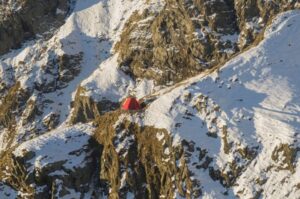What’s it like to walk a mile in the shoes of Canada’s forebears? Endurance adventurer Bert terHart is on a mission to find out what it’s like to walk 4,300 of them.
terHart took off across Canada this month on a canoeing and hiking expedition that will take him across the same river systems that the explorers, cartographers, and First Nations people before him used for millennia.
Just getting started
As I write this, the 63-year-old is advancing through the mountains of Western Canada. On April 26, he pulled into Revelstoke, British Columbia. The following day, he shoved off from the Five Mile Boat Launch and paddled north up Lake Revelstoke.
terHart started on April 1 at Stevenson, B.C., and he’s documented the trip with more or less daily blog posts ever since. terHart’s candid voice is amusingly self-deprecating and conveys a love of the great outdoors. You can also read each post on Instagram.
“I paid dearly for my slothful exit from Big Bear Creek,” he wrote on April 18. “Trusting the forecast to bring more of the same easy miles as the run-up to and past Kelowna, I moseyed down to the beach at the ungodly hour of 8 and saw that the wind had already filled in from the north, and the chop was steepening.
“A flurry of profanity solved nothing. Clearly, I was going to get what I deserved and then some. It was brutal work I don’t hope to repeat anytime soon.”
Hours of toil ensued. terHart made dogged and interruptive progress. Eventually, the wind abated.
“Within an hour of setting out again, the wind began to die. The next 30 minutes saw the wind completely evaporate and the surface of the lake turn to glass. In my life, I have never seen such a large body of water become so still.”
7,000km for the love of nature and nation
terHart will have plenty of days to contemplate natural scenes on what promises to be a methodical traverse. His final destination is Big Shippagan Light, New Brunswick, where he hopes to arrive by November 15.
Ultimately, terHart wants his adventure to resonate historically. “I’m hoping that this trek will enable a more profound insight into the experiences and lives of all those who have come before,” he wrote on his website. “All those whose lives and varied contributions have shaped this amazing country and my home, Canada.”
As a gesture, he and his wife named his canoe (and website) ‘Kai Nani’ — a Polynesian term that refers to a harmonious relationship between wind and water.
How to follow Bert terHart and Kai Nani
You can check out terHart’s whole gear kit and every blog post from the trip on his website. It also includes a link to an up-to-date map that tracks Kai Nani’s live location and speed.
Try not to get too invested in tracking terHart’s every move — you may be staring at the screen for a while.






